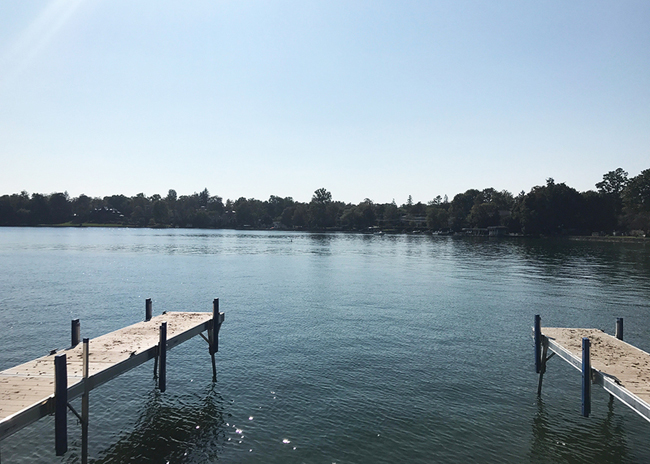Contact:
Jesse Lepak, Ph.D., New York Sea Grant Great Lakes Fisheries and Ecosystem Health Specialist, E: jml78@cornell.edu, P: 315-312-3042
Syracuse, NY, August 1, 2018 - In Summer 2018, New York Sea Grant partnered with the Pennsylvania and Lake Champlain Sea Grant programs and New York State Parks to remind dog owners to enjoy the water this summer, but remember to stay smart, safe, and informed about algal blooms and their impact on people and pets.
For more on the effort, see the June 2018 press release "Stay Smart about Algal Blooms in 2018."
Below are several media stories filed in early June — late July 2018, after the partnership was announced ...
On Air: Be Aware of the Danger to Dogs From Harmful Algal Blooms
Filed by: Steve Penstone, Finger Lakes Daily News
Geneva, NY, June 6, 2018 - It’s the time of year when dog lovers like to take their companions to the water.
Jesse Lepak, Ecosystem Health Specialist with New York Sea Grant, said on Finger Lakes Morning News if you do, make sure Fido avoids Harmful Algal Blooms that contain a number of potentially deadly toxins.
If you don't see the player above, it's because you're using a
non-Flash device (eg, iPhone or iPad). You can download the mp3 file by clicking here (mp3). It may take a few minutes to download, so please be patient.
He described what you should do if your dog dives into the nasty, green slime.
If you don't see the player above, it's because you're using a
non-Flash device (eg, iPhone or iPad). You can download the mp3 file by clicking here (mp3). It may take a few minutes to download, so please be patient.
You can learn more about the harmful impacts of HAB’s on your pets by downloading the online brochure (pdf) from New York Sea Grant and the state Office of Parks, Recreation and Historic Preservation.
Harmful algae blooms could be a problem again in central New York
Filed by: Dakota Palmer, Contributing Writer, The Daily Orange
Syracuse, NY, July 25, 2018 - Harmful algae blooms caused a public health crisis in central New York in fall 2017, and they could become a problem again this summer.
Greg Boyer, a chemistry professor at SUNY-ESF, said this year’s unusually hot summer has provided ideal conditions for the algae to grow in upstate New York lakes. But because HABs have so far lacked a source of nutrients, the blooms have not been growing yet.
Boyer said citizens should expect to see more blooms in late July and early August because heavy rains in mid-July will have washed nutrients into the lakes. The HABs will receive those nutrients with continued hot weather.
As of July 16, the New York State Department of Environmental Conservation has only reported one suspicious, small localized bloom in Onondaga County at Hiawatha Lake. One reported bloom in the Jamesville Reservoir was recently reported to have ended. The neighboring counties of Cortland, Madison and Oswego each have one confirmed bloom.
Last September, Skaneateles Lake in Onondaga County saw HABs in the form of a blue-green algae and higher-than-normal levels of toxins in the water. The lake is a source of drinking water for Skaneateles, Syracuse and other cities in the county.
HABs are most likely to occur at water temperatures between 60 and 86 degrees, according to the New York Sea Grant, a cooperative program of the State University of New York and Cornell University, with administrative offices at Stony Brook University. The blooms appear foamy and most often look like spilled paint. More than 100 beaches in New York state were closed because of HABs last summer.

Skaneateles Lake is a source of drinking water for Syracuse. Credit: Sabrina Koenig, Staff Photographer, The Daily Orange.
Boyer said HABs are a type of bacteria, also referred to as cyanobacteria or blue-green algae.
“They are naturally found in every water body in the state, but under conditions where you get bright sunshine, calm conditions and lots of food in the form of nutrients — nitrogen and phosphorus — they can grow to very thick densities which are called blooms,” Boyer said.
Only about 40 of 8,000 species of cyanobacteria produce toxins, according to the NYSG. Boyer said the New York State Department of Health has advised people to stay out of all blooms for their protection.
The blooms are especially toxic to dogs, which are attracted to the blooms’ odors. Boyer said the blooms can be limited by controlling the nitrogen and phosphorous levels, which are the nutrients for the algae.
Humans can contribute to phosphorus nutrient pollution by using detergents and soaps with phosphate, according to the Environmental Protection Agency. Improper disposal of pet waste or failure to pump out septic systems annually can also contribute to nutrient pollution.
Toxic blooms cannot always be immediately detected. Jesse Lepak, a Great Lakes fisheries and ecosystem health specialist at NYSG, said without testing, it’s not possible to tell if a bloom is toxic. Blooms can also become toxic faster than researchers can obtain test results, he added.
“Algal blooms occur naturally, and they have been around far longer than any monitoring program in place today,” Lepak said. “But the frequency and severity of these events has increased in some areas, and there are growing concerns about the potential negative impacts on the ecology, economy and health of the Finger Lakes region, the Great Lakes basin, and beyond.”
In December 2017, New York state Gov. Andrew Cuomo proposed a $65 million initiative to combat HABs in upstate New York. The proposal identified 12 lakes, including Skaneateles, as critical sources of drinking water that must be protected against algae blooms.

On a Saturday evening late last July, Coco was playing in the water at a campsite on the east shore of Owasco Lake, the sixth largest and third easternmost of New York's Finger Lakes. The following day the 11-year-old American water spaniel became mysteriously ill. A few days later, Coco had to be put down. The cause? It’s unclear, but her owners remembered that there was a blue green algae bloom around their shoreline the day before the stick-fetching incident took place. They don’t recall seeing any algae the night the kids were playing with the dog. There was no further testing done following the dog's death. Nevertheless, Coco's symptoms were consistent with those found by her owners in "HABs and Dogs," a New York Sea Grant advisory to dog owners concerning blue green algae blooms. Credit: NYup.com.
Learn Steps To Protect Yourself and The Pets
Filed by: WXHC FM Radio
Homer, NY June 28, 2018 - Don’t go into or drink water that’s discolored by algae, and keep the pets away. People should suspect that harmful blue-green algae blooms could be present in water that is noticeably discolored or that has surface scums. Colors might include shades of green, blue-green, yellow, brown, purple, white, or red. Water affected by harmful blue-green algal blooms often is so strongly colored that it can have a paint-like appearance. When it comes to drinking water, unpleasant tastes or odors are not reliable indicators of blue-green algal toxins, or other toxic substances.
Some blue-green algae can produce toxins, some do not. However, exposure to any blue-green algae blooms can cause health effects in people and animals when water with blooms is touched, swallowed, or when airborne droplets are inhaled.
According to Dr. Jesse Lepak, Ecosystem Health Specialist with New York Sea Grant, some algal blooms can produce toxins that affect the liver, nervous system and the skin of pets. The most severe reactions comes from drinking contaminated water. The effects are almost immediate and include drooling, tremors and seizures.
These toxins can also destroy the liver. If your dog drinks water where blue green algae is present and starts showing any of these signs, they need to get to a vet immediately. Make sure to wash your dog if it's been swimming in contaminated water so it won't ingest the toxins by licking the fur.
According to the New York State Department of Health exposures to high levels of blue-green algae and their toxins can cause diarrhea, nausea or vomiting; skin, eye or throat irritation; and allergic reactions or breathing difficulties.
What should I do if I suspect a bloom?
- Be able to identify suspicious blooms so you can avoid them.
Avoid it. People, pets, and livestock should avoid areas with blooms or surface scums, or water that is noticeably discolored.
- Never drink it. Never drink untreated surface water. Even if you treat it in your home with water filtration, chlorine, ultraviolet (UV) light, or other treatment; its still may not protected from blue-green algae and toxins.
- Report it. Provide information about suspicious blooms to HABsInfo@dec.ny.gov, your local health department, or harmfulalgae@health.ny.gov.
- Provide information about bloom-related symptoms to your local health department, or harmfulalgae@health.ny.gov.
Tips for protecting pets, livestock from deadly blue-green algae
Filed by: Lindsey Hadlock, Cornell Media Relations Office, E: lmh267@cornell.edu
Ithaca, NY, June 27, 2018 - Blue-green algae is returning to New York
waterways and poses a deadly risk to humans as well as animals.
Karyn Bischoff, toxicologist at the Cornell
University College of Veterinary Medicine, explains the dangers and
advises livestock and pet owners to be vigilant in avoiding contaminated
areas.
Bischoff worked with New York Sea Grant to create a free guide
[/btide/pdfs/HABsBrochure-0814.pdf] for
pet owners on how to spot contaminated waters, how to report blooms to
officials, and what to do if your dog comes in contact.
"Prevention is the best protection for animals. Do everything you can to
stop them from accessing contaminated water,” says Bischoff.
“The most severe effects of Harmful Algae Blooms, including blue-green
algae, are from ingestion, which can occur through drinking contaminated
water or from grooming it off their coats. If your livestock or pet
touches contaminated water, even a small amount, immediately rinse
thoroughly with fresh water. Doing this quickly can be life-saving.
“After rinsing the animal well, contact your veterinarian immediately. Time is of the essence in these cases.
“Clinical signs of Harmful Algae Blooms poisoning depend on the toxins
present and the amount ingested. Small ingestions can cause severe
clinical signs; large ingestions can be rapidly lethal. Neurotoxins can
cause immediate effects, including drooling, tremors, and seizures;
hepatotoxins can destroy the liver and cause rapid death from shock.”
Dogs Particularly Susceptible To Algal Blooms, Expert Says
Filed by: WWNY TV channel 7 News / WNYF channel 28 News
Watertown, NY, June 26, 2018 - Some people like to take their pets to play in lakes or ponds, but health specialists have a warning about the potential risks of algal toxins.
The overgrowth of blue-green algae is increasing in many areas across New York state and the number of dog poisonings from the toxins is on the rise.
Jesse Lepak, an ecosystem health specialist with New York Sea Grant says algal blooms are harmful to both humans and animals, but tend to affect dogs more than other species.
"Dogs in particular can be attracted to some of the odors that will come off of the rotting algae, also what's called beach rack, or some of the vegetation that comes up on the beach -- and they are happy to swim in that."
Lepak was interviewed on 7 News At Noon.
The toxins can cause skin rashes or, if swallowed, problems with the liver or nervous systems.
Symptoms include yellowed teeth or eyes, tremors, repeated vomiting, and seizures.
New York Sea Grant has advice on how to deal with harmful algal blooms at
www.nyseagrant.org/habs.
The state Department of Environmental Conservation has a list of where algal blooms have been reported at its
harmful algal blooms notification page.

Credit: Sheila Sund/Flickr
Pet owners warned of potentially lethal algae in NNY waters
Filed by: Olivia Belanger, The Watertown Daily Times
Watertown, NY, June 7, 2018 - With summer comes time spent in the water, but some of the water may be too dangerous to dive into.
Harmful algal blooms, a dense populations of cyanobacteria most commonly known as blue-green algae, is showing up in increasing frequency across the state. In the right conditions, blooms can produce toxins harmful to humans and potentially lethal to their dogs.
With limited educational resources on these hazards, New York Sea Grant decided to start providing educational brochures to the public on prevention and treatment for their dogs.
Katherine E. Bunting-Howarth, associate director of the New York Sea Grant, said the brochure focuses on algal bloom effects on dogs, rather than humans, for a few reasons.
“A lot of the time we have been trying to keep people safe, but when you think about it, if you go to a lake and it doesn’t look great, people aren’t going to swim in it. But a dog? A dog probably will.” Mrs. Bunting-Howarth said. “We decided to create a brochure that doesn’t just focus on keeping humans safe and started a campaign to let dog owners know what to do and how to react if a dog ingests it or comes in contact with it.”
The blooms are more harmful for dogs in the first place, according to Great Lakes Fisheries and Ecosystem Health expert Jesse M. Lepak. Not only are dogs more susceptible to jumping into a scum-filled lake, the algal bloom is potentially lethal for them.
The liver, skin or nervous system can be affected by the toxins, resulting in green vomit, seizures, disorientation or rashes. These toxins can affect other animals as well, but not as severely as they will affect dogs.
These reactions can be caused by licking their fur after being in the water or from drinking the water. Symptoms can turn lethal in less than 24 hours, and dogs should be taken to the vet immediately if they start to show any of them, according to New York Sea Grant officials.
A veterinarian at Watertown Animal Hospital, Dr. Christopher J. Jank, said he has seen dogs come in after being exposed to the blooms on “very rare occasions.” When he has seen these symptoms, Mr. Jank added, it is usually later in the summer, when the weather is hotter and more humid.
Even so, Mr. Lepak said owners should avoid algal-bloom infested waters entirely because harmful and benign algal blooms look virtually identical.
Signs to look out for are “pea soup-looking water” that has a layer of a green scum. If the water you go to looks like this, Mr. Lepak said, report the location to New York Sea Grant to allow toxin testing.
Currently, there are no initiatives to get rid of the plant, but toxin testing can allow the location to be marked to warn other possible visitors.
While New York Sea Grant’s brochures have recently been adopted in programs in states such as Pennsylvania and Vermont, Mrs. Bunting-Howarth said their job isn’t done yet. New York Sea Grant is continuously working with researchers and communities to better understand algal blooms and how to keep the waters safe for owners and pets alike.
More Info: New York Sea Grant
New York Sea Grant (NYSG), a cooperative program of Cornell University
and the State University of New York (SUNY), is one of 33 university-based
programs under the National Oceanic and Atmospheric Administration’s
National Sea Grant College Program.
Since 1971, NYSG has represented a statewide network of integrated
research, education and extension services promoting coastal community
economic vitality, environmental sustainability and citizen awareness
and understanding about the State’s marine and Great Lakes resources.
Through NYSG’s efforts, the combined talents of university scientists
and extension specialists help develop and transfer science-based
information to many coastal user groups—businesses and industries,
federal, state and local government decision-makers and agency managers,
educators, the media and the interested public.
The program maintains Great Lakes offices at Cornell University, SUNY
Buffalo, SUNY Oswego and the Wayne County Cooperative Extension office
in Newark. In the State's marine waters, NYSG has offices at Stony Brook
University in Long Island, Brooklyn College and Cornell Cooperative
Extension in NYC and Kingston in the Hudson Valley.
For updates on Sea Grant activities: www.nyseagrant.org has RSS, Facebook, Twitter, and YouTube links. NYSG offers a free e-list sign up via www.nyseagrant.org/nycoastlines for its flagship publication, NY Coastlines/Currents, which is published quarterly. Our program also produces an occasional e-newsletter,"NOAA Sea Grant's Social Media Review," via its blog, www.nyseagrant.org/blog.